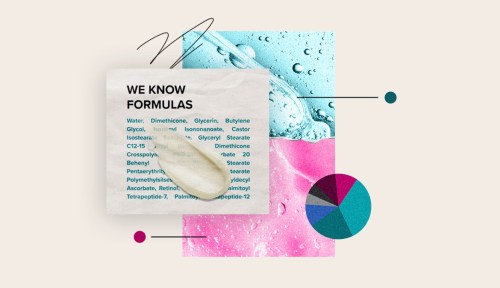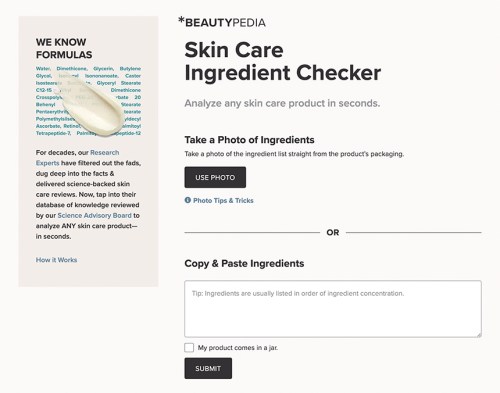Our editors independently select these products. Making a purchase through our links may earn Well+Good a commission
This New and Improved ‘Beautypedia’ Gives You the Power To Suss Out Irritating Ingredients in *Any* Skin-Care Product
The new-and-improved Paula's Choice Beautypedia is here to separate skin-care ingredient fact from fiction.

The science of skin care has beauty lovers in a chokehold. Consumers can’t get enough of figuring out the best ingredients to use and the worst of the worst to avoid. This increased curiosity is, overall, a positive thing—it puts power into the hands of shoppers to curate a routine that feels personal. But considering how much B.S. about skin care there is out there, finding factual, contextualized information often feels next to impossible (looking at you, TikTok). As far as skin-care experts are concerned, the biggest thing consumers should worry about is sussing out whether or not their products contain potential irritants—and the new-and-improved Paula’s Choice Beautypedia helps them do exactly that.
Experts in This Article
What launched in 2008 as just an ingredient dictionary and later became a product-review hub is now a robust search engine that allows you to learn the ins and outs of the ingredient list of any skin-care product out there (read: not just Paula’s Choice products). You’ll see a rating (best, good, average, bad, and worst) for each ingredient that is based on its efficacy and potential for irritation.
“We’ve done away with individually writing product reviews,” says Desiree Stordahl, director of applied research & education at Paula’s Choice, “and have really taken the same way we used to do those product reviews, which was driven by this data in our ingredient dictionary, and sent that into a tool that you can now just copy and paste an ingredient list or take a picture of an ingredient list and it will give you this quick snapshot of the good and the bad ingredients. And then you can click through to learn more about each individual ingredient.”

What sets Beautypedia apart from other skin-care ingredient databases is that it uses research that has been examined and contextualized by scientists so you only see relevant information. For example, a 2004 study done on rats isn’t going to get the same weight as a 2019 clinical study performed on humans.
This Parisian Skincare Brand Is Launching in the United States for the First Time—Here’s What a Derm Wants You to Know

We’re Calling It: Cleansing Balms Are the Face Wash of the Future—Here Are 3 to Add to Your Cart

This Is the One Product That Scarlett Johansson Always Keeps in Her Purse and on Her Bedside Table

“How we classify good or bad ingredients is truly based on the published research,” says Stordahl. “What we’re using is things that you can find on PubMed or a source called DeepDyve, which is behind a paywall, but we pay to get the studies to get the research behind the ingredients. The quality of research we do is very high. We also have a science advisory board of dermatologists, safety experts, and environmental scientists who then review everything. Before information goes live on our site, we run it by them to make sure everything we’re saying is factually correct.”
To get a “good” rating, an ingredient is considered to be outstanding with true benefits for skin that have been proven and supported by independent studies. To get the”worst” rating, an ingredient must be proven to cause irritation, inflammation, dryness, etc. “We also notate that it depends on the concentration of the ingredients,” says Stordahl. “So obviously when you see an ingredient that is bad at the top of a [product’s] ingredient list, that’s gonna be worse for you than if it’s the very last ingredient, meaning it’s in tiny minuscule concentration.” [Editor’s note: That’s because skin-care formulas list their ingredients in order of most to least concentration].
And if you come across an ingredient that’s “unknown,” you may need to just adjust the spelling. If not, it may just not be on the list yet. “Just know that our team is constantly working on updating the ingredient dictionary that feeds this tool,” adds Stordahl.
What I love about this tool is how much it allows you to learn. Sort functionality allows you to view the ingredient breakdown from highest to lowest concentration, from best to worst, from worst to best, by skin benefit, and by formulation function. For example, after throwing a random product into the tool I was able to learn that steric acid is a hydrating emollient that protects the skin’s surface against water loss and strengthens its moisture barrier.
While the database is fueled by robust research, keep in mind that it’s still being filtered through the Paula’s Choice lens. The research that feeds this tool is the same research PC uses to formulate its products, so you’re not gonna pop in a PC product and see a “bad” or “worst” ingredient. And know that some ingredients that PC considers “bad” can be well-tolerated depending on the person. For example, PC doesn’t use fragrance in any of its products as fragrance is a common skin irritant, especially in those with sensitivities and skin conditions like eczema. Therefore all fragrances (natural and synthetic) get a “worst” rating. However, many people tolerate fragrance just fine and might even consider fragrance as a positive addition.
I’ve played around with the tool and popped in products from thoughtful, science-backed, dermatologist-formulated brands and seen ingredients pop up with “bad” and “worst” ratings. So to get the most out of the tool, click in to learn about the different ingredients and determine your limits and how you want to build out your own routine.
“Knowledge isn’t always power if it’s creating anxiety and undo stress,” says Caren Campbell, MD, a board-certified dermatologist in California. “For example, I put a trusted skincare product into the checker and it sent back the main active ingredient as ‘bad.’ The ingredient is actually wonderful for inflammation of the skin, but when used too frequently can cause irritation. This doesn’t make it ‘bad’ it just requires appropriate counseling from me as the dermatologist recommending the ingredient to the patient.”
So to get the most out of the tool, click in to learn about the different ingredients and determine your limits and how you want to build out your own routine. If you analyze a product and realize it’s got more potenrially irritating ingredients than you’re comfortable with, you can also use this site to find an alternative from Paula’s Choice. This introduces another bias, but at the end of the day, it’s their tool—I’d never expect a brand to actively promote products from competitors. Plus, it’s undeniable that the tool can fuel many, many purchases of products from other brands if shoppers drop in an ingredient list and like what they see.
“Paula’s Choice from the get-go from the inception of this brand, from Paula Begoun herself has always started at the root of giving people information,” says Stordahl. “Our slogan is ‘Beauty Begins with Truth.’ So Paula started that out by writing books and her books told people what the good and bad ingredients were. That was before she even came out with Paula’s Choice as a line. And so if you think about our brand’s core purpose, it’s always to inform people, educate people, and give them the tools to make the best decisions for their skin, whether it’s from our line or somebody else’s.”
Sign Up for Our Daily Newsletter
Get all the latest in wellness, trends, food, fitness, beauty, and more delivered right to your inbox.
Got it, you've been added to our email list.







